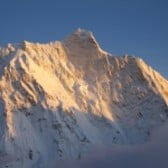
Daily Mountain
48 years, Australia
Scientists Find Warm Ice in World’s Highest Glacier
Ice temperatures of Khumbu glacier in the Mt Everest region have been higher than expected, a scientific research has found, indicating that floods and droughts are likely to become more common, and glacial lake growth along with its hazards will increase in coming decades.
 A specially adapted car wash unit that produces a pressurised jet of hot water to drill boreholes as far as 190 metres into glacial ice drilling a hole into Khumbu glacier. Photo courtesy: EverDrill Project
A specially adapted car wash unit that produces a pressurised jet of hot water to drill boreholes as far as 190 metres into glacial ice drilling a hole into Khumbu glacier. Photo courtesy: EverDrill Project
Sharing the findings of the Everest region drilling project ‘EverDrill (2016-2019)’, lead scientist from the UK-based University of Leeds Duncan Quincey said more than half of the ablation area of Khumbu glacier contained warm ice.
“We found that 56 per cent of the ablation area of Khumbu glacier comprised warm ice,and even the coldest ice is only 3.3°C lower than the melting point,” he told THT.
The EverDrill project, a joint venture of universities of Leeds, Aberystwyth, Sheffield and Kathmandu and the Himalayan Research Centre, had been carried out at a height of up to 5,200 metres on the Khumbu glacier while the research team used a specially adapted car wash unit that produced a pressurised jet of hot water to drill boreholes as far as 190 metres into the glacial ice, he said. Strings of temperature sensors were installed into the boreholes and left to collect data for several months, he said.
Researchers found that there was evidence to suggest that the ice was warming at a rate of around 0.5°C per decade, while floods and droughts were likely to become more common and glacial lake growth along with its hazards would increase in the coming decades.
The results indicated that high-elevation Himalayan glaciers were vulnerable to even minor atmospheric warming and would be especially sensitive to future climate warming, Quincey said. “The coldest ice we measured was just -3.3°C near Mt Everest base camp and this is warmer than we might expect for a glacier at this elevation.”
Most of the ice was warmer than the air temperature. This means that further warming will accelerate the glacier melt, according to the study.
“In the short-term melting will increase, but in the longterm it will decrease as periods of floods and droughts become more common.”
Warm ice is particularly vulnerable to climate change because even small increases in temperatures can trigger melting, Quincey added.
“Internal temperature has a significant impact on the complex dynamics of a glacier, including how it flows, how water drains through it and the volume of meltwater runoff – which makes up a crucial part of the water supply for millions of people in the Hindu Kush Himalaya region,” the scientist added.
Air temperatures in Solukhumbu will continue to increase and precipitation will become more unpredictable, shows the research. It adds that Khumbu icefall and other mountain routes might become more dangerous for climbers in the coming days.
“Rockfall will become more common while ponds and lakes may burst suddenly, causing danger and damage to downstream property and infrastructure.”
According to Himalayan Research Centre Chairman Dhananjay Regmi, in 2017 the research team led by Quincey had drilled for the first time into Khumbu glacier to record temperatures deep below the surface layer. “At least 27 boreholes into the Khumbu Glacier were drilled to measure ice temperatures while the research team used five different sites during two field seasons – 2017 and 2018 – of the project,” he said. Quincey led the project overseeing the remote sensing aspect while drilling was led by Prof Bryn Hubbard from Aberystwyth University, he added.
This article first appeared on http://thehimalayantimes.com. The original can be read here.





